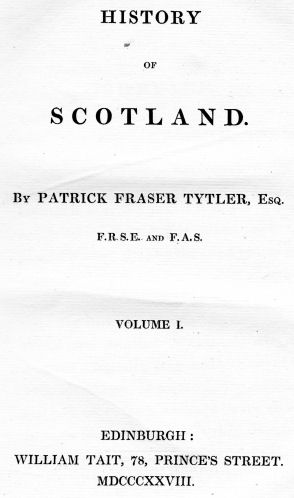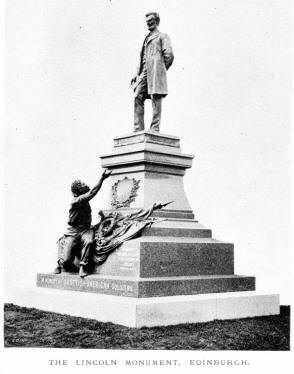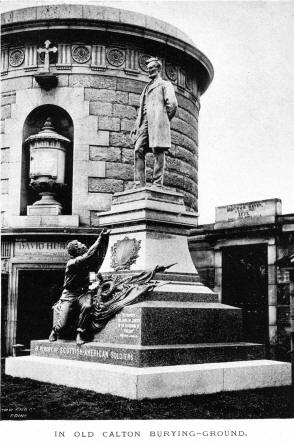|
THE STORY OF THE MONUMENT.



IN the summer of 1890,
Mrs M'Ewan, widow of a Scottish-American soldier, called on Mr Wallace
Bruce, United States Consul at Edinburgh, to aid her in securing a
pension from the Government in Washington, as her husband had recently
died. The proper proof was obtained and the pension granted. One day
when she called at the Consulate, Mrs Bruce chanced to be present, and
became interested in her story: how Sergeant M'Ewan, wearing the blue
army coat with brass buttons, came to the mill in Galashiels where she
was employed, and how, in recesses from work, little groups would
gather about him as he told incidents of the war. She said she had
read 'Uncle Tom's Cabin,' and the poetry of Whittier, which, she
thought, chimed so sweetly with the songs of Burns.
One day this soldier told the story of his life and won her. Some
years afterwards they came with their little family to live in
Edinburgh. Sickness entered the household, the father was unable to
work. He applied to the Government for a pension, but failed, as he
was unable to connect his ailment with exposure on the field. Mrs
M'Ewan told Mrs Bruce how she and her children had worked for five
shillings a-week to keep husband and father from the poorhouse, and
gave with singular pathos the account of his last illness: how he
loved to have the old gun near at hand where he could touch it; how he
told the doctor on one of his last visits that he had nothing to give
him but his sword, and the kind-hearted doctor replied that it was his
business to save life, not to take it, and that he wished neither the
sword nor any other recompense but pleasant remembrance, and the wife
said, "We will keep the sword for the laddie"; and at last, when the
poor soldier, after long months of suffering, died, they found the gun
under the coverlet beside him, pressed close to his heart.
Mrs Bruce asked where he was buried, that she might go with Mrs M'Ewan
and place some flowers on his grave, although Decoration Day had
passed; but the widow answered, with tears in her eyes: "The ground in
the common field is all level; I couldna mark the spot. In fact, the
next Sabbath after his death I visited it with the bairns, and we
found another mourning group had possession. Another body was being
buried in the same grave."
This story, told in the beautiful Border language of the Tweed and the
Yarrow, suggested to Consul Wallace Bruce the idea of a burial-place
in Edinburgh for Scottish-American soldiers. He wrote to several
American friends, and talked with others who, visited at the
Consulate. All heartily approved of the plan. Some time afterwards Mr
Bruce was walking on the banks of the Tweed, near Peebles, with Lord
Provost Russell, of Edinburgh. He told Mrs M'Ewan's story, and the
following day wrote a letter to the Lord Provost, Magistrates, and
Town Council, asking for a plot in one of the city cemeteries. The
request was cordially granted. It then occurred to the Consul that the
spot should be marked with a memorial worthy of the site in the very
heart of the beautiful city.
Early in August Mr Bruce sailed for New York to deliver the Grand Army
Chautauqua Address at the request of Bishop Vincent, Chancellor of the
Chautauqua Assembly, where over five thousand people, army veterans
and their friends, were gathered, with the late ex-President Hayes in
the chair. It was in this address that Mr Bruce first publicly
announced his idea of a bronze statue of "Lincoln Freeing the Slave,"
as a fitting monument in Great Britain — this being the final act of
Saxon freedom. Mr Henry R. Heath, a veteran and lifelong friend of the
Consul, was present. He entered heartily into the idea, and was made
chairman of the committee of arrangements.
Estimates for the monument ranged from six thousand to eight thousand
dollars. The contract was awarded to Mr George E. Bissell, a
well-known sculptor and army veteran. Mr Bissell estimated the exact
cost of the bronze figures at four thousand dollars, and agreed to
furnish them at this price if necessary. The granite work was
estimated at about one thousand dollars: proposals came in varying
from about one thousand to twenty-four hundred dollars. Messrs Stewart
M'Glashen & Son, of Edinburgh, undertook the stone-work and lettering
for about nine hundred dollars. Mr Bruce then issued a prospectus with
a picture of the proposed monument, and before taking the steamer for
Edinburgh last November, personally saw thirty men who agreed to give
one hundred dollars each.
During the months of December, January, and February, the amount
subscribed reached six thousand dollars, which is gratifying to the
Committee, as it enables the sculptor to get some recompense besides
fame for his labour. Thus, in ten months after announcement, the work
was accomplished, and the monument was unveiled on Monday, 4.30 p.m.,
August 21st.
It is fifteen feet in height, Lincoln in bronze, life-size, with freed
slave at his feet, and battle-flags also in bronze, base of polished
red Aberdeen granite. Sir William Arrol, a true Scot and a self-made
man, such a man as Lincoln would like to have known, was fittingly
selected as chairman.
A few years since Sir William Arrol was given the freedom of Ayr, and
in his speech said, "Thirty years ago I walked through your burgh with
my blacksmith tools, asking for work." Hundreds and thousands of
Americans to-day look at his great Forth Bridge, a triumph of modern
engineering. Mr Bruce, in inviting him, as chairman of the ceremony,
fittingly said, "It is the problem of the future to bridge wide oceans
and make one family of all nations. Your presence as chairman will
rivet another link between our two great English-speaking nations."
In the absence of the Honourable Chauncey M. Depew, who had promised
to give the address, and fully expected to be present until the last
moment, Mr Wallace Bruce presented the monument to the city. It has
been a work of love on the part of the United States Consul. The idea
was happy, and it has been gracefully executed. It will stand as a
monument of love to old Scotia, and will form another link of
friendship and goodwill between the nations.
List of Subscribers
Each of the following
gentlemen subscribe one hundred dollars to the undertaking.
New York
Levi P. Morton, Wm. Walter Phelps, Cornelius Vanderbilt, Andrew
Carnegie, Alexander King, Charles Stewart Smith, John S. Kennedy,
William Rockefeller, John Sloane, William Clark, J. Pierpont Morgan,
E. C. Benedict, James H. Benedict, . Wm. Waldorf Astor, Daniel
Appleton, Harper & Bros., J. Kennedy Tod, John B. Dutcher, Solomon
Turck, Caledonian Club, Henderson Bros., Merritt & Ronaldson,
Brooklyn, N.Y.
David A. Boody, John Arbuckle, Henry B. Heath, Francis H. Wilson,
Andrew D. Baird, Andrew R. Baird, Alexander S. Baird, William W.
Baird, Joseph Stewart,
Poughkeepsie, N.Y.
Henry L. Young, Andrew Smith, . John Donald, Wallace Bruce,
Chicago, Ill
Robert Clark, Peter M'Ewan, A. M. Wright & Co., Caledonian Club,
Geo. Peabody Wetmore, Newport, R.I.
James Coats, Pawtucket, R.I.
Peter Kinnear, Albany, N.Y.
J. E. Munger, Fishkill, N.Y.
S. D. Coykendall, Rondout, N.Y.
J. Watts de Peyster, Tivoli, N.Y.
Edwin B. Sheldon, Delhi,N.Y.
Geo. E. Lemon, Washington, D.C.
Nathan Bickford, Washington, D.C.
R. B. Leuchars, Boston, Mass
Henry Norwell, Boston, Mas
W. J. Murphy, Phoenix, Arizona
J. B. White, Ft. Wayne, Ind.
Edward White, Ft. Wayne, In.
David C. Bell, Minneapolis, Minn.
Alex. M'Donald, Cincinnati, O.
Lynde Harrison, New Haven, Ct.
John Beattie, Leets Island, Ct.
Thomas Waddell, West Pitston, Pa.
John Young, Jersy City, New Jersey
Geo. W. Childs, Philadelphia, Pa.
Franklin Fairbanks, St. Johnsbur, Vt.
William E. Bartlett, Edinburgh, Scotland
S. M. Burroughs, London, England
Total raised $6,300. |

